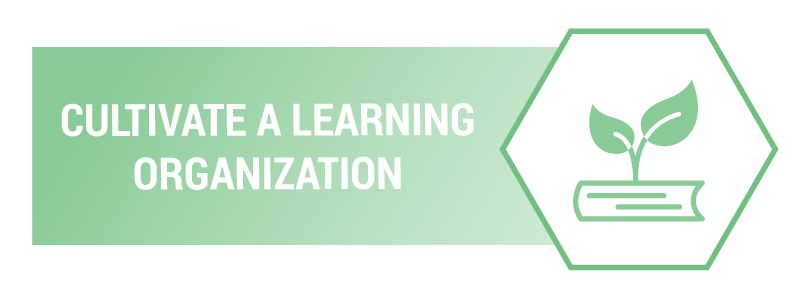Domains of Business Agility
- Responsive Customer-Centricity
- / Fiercely Champion The Customer
- / Sense & Respond Proactively
- / Integrate Diverse Ideas
- Engaged Culture
- / Cultivate A “Learning Organization”
- / Engage Transparently & Courageously
- / Embed Psychological Safety
- / Act As One
- Value-Based Delivery
- / Unleash Workflow Creatively
- / Prioritize. Prioritize. Prioritize.
- / Deliver Value Sooner
- / Seize Emergent Opportunities
- Flexible Operations
- / Adapt Strategies Seamlessly
- / Fund Work Dynamically
- / (Re)Organize Structures Fluidly
- / Balance Governance And Risk
- People-First Leadership
- / Foster Authentic Relationships
- / Empower With Accountability
- / Realize People’s Potential
A “Learning Organization” is always in motion. It seeks new insights and knowledge — whether from outside or within — and uses that knowledge to improve itself. At an individual level, this is called a growth mindset: the recognition that your talents and abilities can be continuously improved. At the organizational level, it is about recognizing that there is always something to learn from ourselves, from others, from our customers, and from the world.
This relentless pursuit of continuous improvement requires individuals and organizations to be open to learning opportunities, both planned and unexpected. Planned learning can be as simple as taking the time to inspect what is happening now, or it can come from investing in formal experiments and prototypes to see what’s possible. Unexpected learning emerges out of accidents, failure, and mistakes. In turn, this requires a willingness to accept and talk about failure.
Primary Behaviors
The following 6 behaviors strongly contribute to the ability to cultivate a “learning organization”.
B14: Everyone shares learnings and they are appropriately applied: Regardless of whether something is a success or not, people share what they have learned widely across the organization, and these learnings are used by other parts of the organization.
B15: Everyone prioritizes high risk work to determine viability of options and next steps as quickly as possible: When identifying what to do next (at whatever level of granularity is appropriate) everyone involved takes into account the risk and value of each. Work is prioritized to those with the highest uncertainty and highest value in order to rapidly learn if the risks can be mitigated and if the value is attainable. In other words, fail fast.
B16: Everyone deliberately designs and runs experiments based on hypotheses, observations, ideas, and feedback: Deliberately explore and test ideas with a "beginner's mind" where you don't have predetermined expectations of what you are trying to prove.
B17: Everyone frequently seeks and iterates on feedback regardless of the source (e.g. employees, customers, or stakeholders): "Feedback is a gift" is not a slogan - it is a lived value. It is built into how you work. Everyone at every level is actively seeking feedback and uses that feedback to adjust their own behaviors and identify changes needed to improve products and services.
B18: Leaders make decisions balancing available information, risk, and urgency: Decisions are made with the best information and data available at the time, rather than blind assumptions, random guesses and historical (old and possibly no longer relevant) data.
B19: Leaders recruit employees based on mission-alignment, culture add, and a growth mindset: Leaders take a broader perspective than the organization’s short term needs when considering hiring someone. Considerations include how the candidate’s mindset and values align with the organization’s mission; the growth and evolution of the organization’s culture; and the degree that a candidate’s mindset is growth oriented (rather than fixed).


